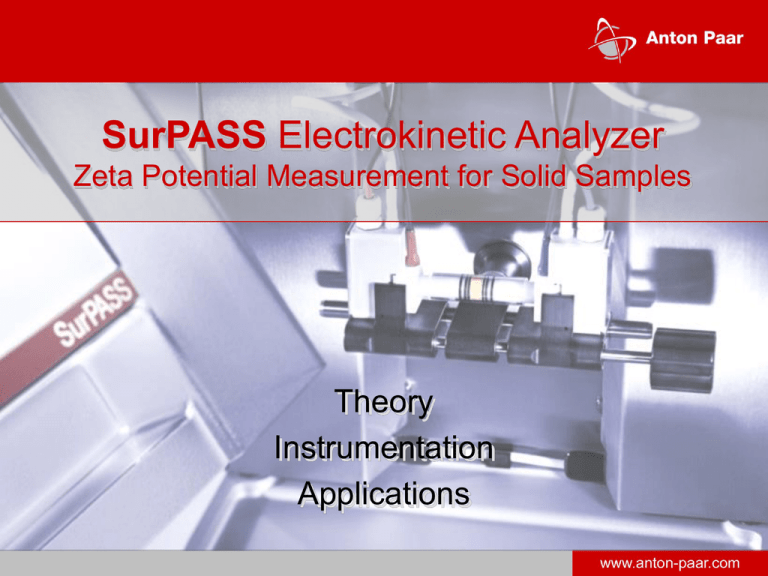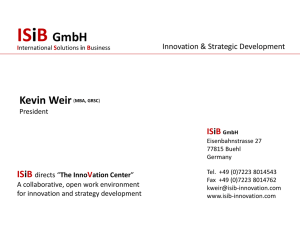
SurPASS Electrokinetic Analyzer
Zeta Potential Measurement for Solid Samples
Theory
Instrumentation
Applications
Surface and Interface Analysis
Secondary Ion Mass Spectrometry
X-ray Photoelectron Spectroscopy
Energy Dispersive X-ray fluorescence
Raman spectroscopy
Ion Scattering Spectroscopy
IR, UV/VIS spectroscopy
Microscopy
Scanning Electron Microscopy
Transmission Electron Microscopy
Atomic Force Microscopy
Confocal Laser Scanning Microscopy
Light microscopy
Analysis of …
… chemical composition of surface
… surface topography
… morphology of interfaces
Interface analysis
Contact angle (static, dynamic)
Surface tension
Streaming potential
Surface spectroscopy
Gas adsorption
… surface energy and (de-)wetting
© Anton Paar GmbH 2006
Spectroscopy
Streaming Potential Method
Liquid phase (electrolyte solution) pumped through the measuring cell (containing sample)
pressure difference
relative movement of the charges in the electrochemical double layer
detection of streaming potential U = U(p)
electrode
sample
electrode
© Anton Paar GmbH 2006
flowing
liquid
Mechanism of Streaming Potential
+ +
+ + + + + +
- - - - - - - - - - Fluid Flow
+ +
+ + + + + +
+
Fluid Flow
- - - - - - - - - - -
Backflow Current
+
+ + +
+ + +
- - - - - - - - - - -
Ion accumulation causes potential difference
Potential difference causes backflow current
© Anton Paar GmbH 2006
+
Electrolyte flow forced across solid surface
+ + +
+ + +
- - - - - - - - - - +
Electrochemical double layer at equilibrium
SurPASS Measurement Set-Up
RS 232
pH
Conductivity
VisioLab for SurPASS
© Anton Paar GmbH 2006
SurPASS Electrokinetic Analyzer
Cylindrical Cell
electrolyte
inlet/outlet
electrode
Natural and technical fibres
Hair
Textile fibres and fabrics
Powder samples with > 25 µm size
Particle and granular samples
electrolyte
inlet/outlet
© Anton Paar GmbH 2006
sample
perforated
disc
Clamping Cell
25 5 mm2
Flat membranes
Foils
Polymer sheets
Rigid samples of different thickness
and shape with a flat surface
spacer
sample
© Anton Paar GmbH 2006
electrolyte
inlet/outlet
Pressure Ramp Measurement
Electrolyte flow from left right
Measurement of streaming potential at
various differential pressure
Reversal of flow direction
=
dU
dp
0
© Anton Paar GmbH 2006
Linear regression for evaluation of
“pressure ramp” slope
Polymer industry
Synthetic fibre and textile industry
Processing of non-metallic, inorganic
materials
Mining industry
Printing industry
Membrane and filtration technology
Biomaterials
Semiconductor industry
Paint and varnish industry
Cosmetics industry
etc.
© Anton Paar GmbH 2006
SurPASS Applications in . . .
Textile and Technical Fibres
Textile purification
Fibre swelling
Hydrophobicity
Particle retention
Glass fibre finishing
Characterization of sizing agents
Surfactant interaction
etc.
© Anton Paar GmbH 2006
Characterization of Polyester Fibre
Preparation
Field of Application
Solution with SurPASS
Treatment of synthetic fibres with surfaceactive compounds after spinning to assure
textile processing
Time resolved measurement of treated
polyester fibres in Cylindrical Cell
0
Challenge
untreated
anionic
cationic
non-ionic
Zeta potential (mV)
T = 60 min
-20
T = 0 min
T = 15 min
-35.10
-34.93
-55.49
-57.49
-48.68
-51.75
-48.36
-22.22
-28.22
-32.24
-50
-24.92
-29.41
-18.32
-18.15
-16.8
-13.17
-16.11
-60
100
-37.32
-36.87
-30
-40
150
200
250
Adhesive Length (10-6 N/tex)
300
© Anton Paar GmbH 2006
Surfactant
-10
Zeta Potential (mV)
Characterization of these surface-active
compounds to forecast textile
processibility of fibres
Glass Fibre Finishing
60
untreated
sized
AMEO
40
Electrokinetic measurement
shows higher sensitivity to
changes in surface chemistry of
glass fibres than contact angle
measurement
20
140
-20
-40
120
sv = 47.8 mJ/m2
100
sv = 49.6 mJ/m2
80
60
40
20
0
-60
2
3
4
5
6
7
8
-3
pH (in 10 M KCl)
9
10
11
15
25
35 45 55
lv (mJ/m2)
65
75
© Anton Paar GmbH 2006
0
K lv cos
Zeta Potential (mV)
Zeta Potential of Human Hair
Rinse
10
Shampoo
-20
-30
-40
-50
Source: E.D.Goddard, P.S.Leung, Sonderdruck aus Parfümerie und Kosmetik 68 (1987)
© Anton Paar GmbH 2006
-10
Rinse
0
Conditioner
Zeta Potential (mV)
20
Untreated
30
Polymer Characterization
Surface modification
Lacquer adhesion
Composite materials
Hydrophobic vs. hydrophilic behaviour
Wetting and de-wetting behaviour
etc.
© Anton Paar GmbH 2006
Protein adsorption in biomaterials engineering
Hydrophilisation of Polyolefines
10
Aim
0
Modification of the polymer surface
properties with retention of the bulk
behaviour
Example
Introduction of acidic surface groups
-20
100
-30
-40
-50
untreated
1 min
2 min
3 min
4 min
5 min
80
60
40
20
0
-60
2
3
4
5
6
7
pH
8
9
10
11
0
1
2
3
4
5
Treatment Time (min)
© Anton Paar GmbH 2006
Contact Angle (°)
Zeta Potential (mV)
-10
Plastics for Medical Application
10
untreat w/o hep
amine-mod w/o hep
untreat w/ hep
amine-mod w/ hep
5
Field of Application
Membrane material for
haemodialysis
Challenge
-5
Compatibility of membrane material
with human organism
-10
Solution with SurPASS
-15
Zeta potential determination of
capillary membranes in Cylindrical
Cell and flat membranes in
Clamping Cell
Examination of plastics surface in
natural aqueous environment
-20
-25
-30
2
3
4
5
6
7
pH
8
9
10
11
© Anton Paar GmbH 2006
Zeta Potential (mV)
0
Metal Oxide and Semiconductor
Processes
Photoresist coating
Silicon wafer cleaning
Metal layer characterization
Particle adhesion
etc.
© Anton Paar GmbH 2006
Chemical Mechanical
Polishing
Electrokinetic Measurement of
Aluminium Sheets
50
Treatment
Alkaline pickled with NaOH and Na2CO3
and boiled in H20 for 10 min
Alkaline pickled only
Alkaline and then acid pickled with H2SO4
and H2O2
40
20
10
Results
0
-10
-20
alkaline pickled/boiled
-30
alkaline pickled
-40
alkaline/acid pickled
-50
3
4
5
6
7
pH
8
9
10
11
Alkaline pickling and boiling introduces
only few dissociable surface groups
with no plateau in zeta potential
and IEP in the neutral range
Procedure produces AlOOH
(Böhmit) on Al(OH)3 (Bayerit) layer
More dissociable surface groups
without boiling
plateau in zeta potential at low pH
IEP shifted towards higher pH
Source: C. Bellmann et al, Fresenius J Anal Chem 358 (1997) 255
© Anton Paar GmbH 2006
Zeta Potential (mV)
30
Electrokinetic Measurement of
Aluminium Sheets
50
40
30
Alkaline pickled with NaOH and Na2CO3
and boiled in H20 for 10 min
Alkaline pickled only
Alkaline and then acid pickled with H2SO4
and H2O2
Application of organic oligomer material with
acidic functional groups
20
10
0
Results
-10
IEP changes to lower pH
Ion adsorption processes dominate
Oligomer removed for alkaline/acid
pickled Al surface at pH > 7
-20
-30
-40
-50
3
4
5
6
7
pH
8
9
10
11
Source: C. Bellmann et al, Fresenius J Anal Chem 358 (1997) 255
© Anton Paar GmbH 2006
Zeta Potential (mV)
Treatment
alkaline pickled/boiled
alkaline pickled
alkaline/acid pickled
Particle Deposition on Si3N4 Wafer
0
0
-10
-10
-20
-20
-30
-30
-40
-40
-50
-50
3
4
5
6
7
8
9
Ratio
10
Sample Treatment
10
pH
1200
Conc. of PSL
Piranha
0
800
-10
600
-20
400
-30
200
-40
0
-50
2
3
4
5
6
pH
7
8
9
10
Zeta Potential (mV)
Particle no. on wafer
Si/N
Si/O
N/O
Piranha
0.77
2.99
3.88
3.7
Piranha + BOE
0.81
3.78
4.66
5.3
Piranha, BOE + H3PO4
0.80
2.53
3.16
3.5
Zeta potential depends on cleaning
treatment of LPCVD Si3N4 wafers
Correlation between N/O ratio (XPS data)
and IEP
Contamination of wafer surface with
Polystyrene particles follows the zeta
potential
10
1000
IEP
Source: D.Jan, S.Raghavan, Proc. 3rd Int. Symp. on Cleaning
Technology in Semiconductor Device Manufacturing (1993)
© Anton Paar GmbH 2006
10
Zeta Potential (mV)
20
Piranha
Piranha + BOE
Piranha, BOE + H3PO4
RCA 1
Zeta Potential (mV)
20
CMP Slurry / Cu Surface Interaction
30
cationic
25
non-ionic
anionic
Zeta Potential (mV)
20
15
10
5
0
-10
cationic
non-ionic
anionic
dodecyl trimethyl ammounium bromide
Marlipal O13/100 (C13-alcohol
polyethylene glycol ether)
sodium dodecyl sulphate
-15
1E-07 1E-06 1E-05 1E-04 1E-03 1E-02
surfactant concentration in 10-4 M KCl (mol/l)
© Anton Paar GmbH 2006
-5
© Anton Paar GmbH 2006
Partial List of EKA Customers






